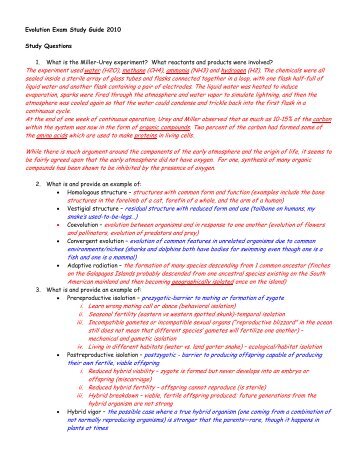Evloution And Geologic Time Study Guide Answers
Study Flashcards On Chapter 12 Earth's Evolution Through Geologic Time at Cram.com. Quickly memorize the terms, phrases and much more. Finally, and if the fossil record is complete enough, their study can help us better understand the evolution (or progression) of life through geologic time.
Fossils are physical evidence of preexisting organisms, either plant or animal. The most common and obvious fossils are the preserved skeletal remains of animals. Other fossils, which are also evidence of past organisms, include leaf impressions, tracks and trails, burrows, droppings, and root casts. Microfossils are the microscopic skeletons of previously existing plants or animals, and their examination requires an optical or an electron microscope for close study.
A very small fraction of the organisms that have lived on the Earth is found in the fossil record: Many did not possess skeletons or other hard parts that could be preserved; many did not survive the process of fossilization, wherein skeletons and tissues are replaced by minerals; and many were subsequently destroyed either by chemical or physical processes such as recrystallization, metamorphism, or erosion. Fossils of any kind are useful in 'reading the rock record,' meaning they help us decipher the history of the earth. They can help us determine the geologic age and environment (the paleoenvironment) in which they were deposited.
Finally, and if the fossil record is complete enough, their study can help us better understand the evolution (or progression) of life through geologic time. Our understanding of the meaning of fossils is based on the accumulated knowledge from previous generations of investigators who carefully recorded the identity and distribution of fossils from numerous geologic exposures or samples from wells and recorded their findings in the scientific literature.
When the regional or global distribution of fossils through geologic time is taken into consideration, we can gain important insights into such phenomena as continental drift, community migration, and climatic (paleoclimatic) reconstruction. Geologic Time In geology, we can refer to 'relative time' and 'absolute time' in addressing the age of geologic formations or rock units. Chronostratigraphy is the branch of geology that studies the relative time relations and ages of rock units. In chronostratigraphy, we are concerned with the age relations between rock bodies irrespective of their absolute (numerical) age.
Fossils provide us with a rapid and accurate means of determining the relative age of rocks in a stratigraphic sequence. We cannot assign an absolute age to the fossils until we have a time scale. Geochronology is that branch of stratigraphy concerned with the dating and subdivision of geologic time and the establishment of time scales. Before geologists had a means to determine the actual ages of rocks, their correlations were based on the superposition of rock strata, that is, older rocks are deposited before younger rocks. Geologic time was subdivided into a hierarchy of chronostratigraphic units of unknown duration. The application of radiometric dating techniques to determine the absolute ages of rocks resulted in the discipline of geochronology and the ability to establish geologic time scales.
Evolution And Geologic Time

There is no single location on earth that has experienced a continuous and uninterrupted accumulation of sediments or rocks that could be dated and that could yield an ideal reference time scale. A chronostratigraphic scale is not discovered; it is established by agreement among numerous geologists and is based on a composite of sections. Farmall 656 gas tractor.
An ideal chronostratigraphic section that would be part of a larger composite section would possess the following attributes: a sequence of points representing essentially continuous, and preferably marine, deposition; fossils that are abundant, distinctive, diverse, cosmopolitan, and well preserved, and without major paleoenvironmental changes; minerals for isotopic age determinations, and a record of geomagnetic polarity reversals. Additionally, these 'type' sections would be well exposed, have reasonably permanent accessibility, and be readily correlated to other sections. Once a chronostratigraphic scale is agreed upon, it serves as a recognized standard and generally stands unchanged until it is reevaluated and modified with even better stratigraphic sections or with improved analytical instrumentation.
As a result, no chronostratigraphic scale is ever totally finalized. A chronostratigraphic scale that is integrated with absolute ages (geochronology) is called a geologic time scale. Nearly two dozen time scales have been proposed since Arthur Holmes published his first one in 1913. Each scale incorporated the latest developments in standard stratigraphic sections, biostratigraphy, and age-dating. The latest time scale, edited in 2004 by Felix Gradstein and colleagues, incorporated high-resolution radiometric and astronomical age-dating into a comprehensive time scale for the last 3.850 billion years (the age of the earth being 4.54 billion years).
No doubt the 2004 time scale will ultimately be replaced, but until then, it will serve as a reference standard to which all geologic units can be correlated and assigned an absolute age.